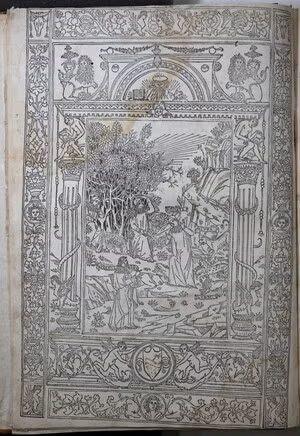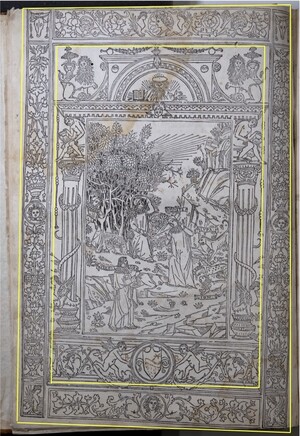The subject of our first “Diving Deeper” series is Dante’s Divine Comedy to commemorate the 700th anniversary of Dante’s death on September 14, 1321.
“Nel mezo del camin di nostra uita” — the Florentine poet, Dante Alighieri (1265-1321), tells his readers at the beginning of the first canto of Inferno that he has gone astray in the middle of his life. Dante’s Divine Comedy as it is commonly known today took the fourteenth century by storm. Over 600 manuscripts from that century alone and more than 800 copies from the Middle Ages — though no manuscript in Dante’s own hand — survive. Then, with the advent of printing with moveable metal type in Germany in the mid-fifteenth century and the spread to Italy in the 1460s and 70s, numerous editions of the Comedy appeared. In Italy the first copy dates from 1472 and by 1500, 15 editions were printed. See image below. Follow this link for larger image Inferno Canto Detail

Rare Books and Manuscripts (RBM) holds an illustrated edition of Dante’s Divine Comedy published in 1493 in Venice by Matteo di Codecà da Parma. This volume is one of ASU’s incunables (incunabula in Latin), meaning it is a book printed in the West using moveable metal type from roughly 1455 to the end of 1500. Matteo di Codecà’s printing rounds out a set of three related editions printed in Venice by Pietro di Piasi, dated 18 November 1491, 3 March 1491 [1492] (recent scholarship has determined the year printed in the colophon should be 1492) and 29 November 1493. Di Piasi’s editions provide the first complete cycle of illustrations for the Comedy. Matteo di Codecà used the blocks from his 1491 edition to print the illustrations in his 1493 edition.
Opening each cantica (Inferno, Purgatorio, and Paradiso) is a full-page woodcut, shown below. Follow these links for larger images: Inferno woodcut Purgatorio woodcut Paradiso woodcut



Completing the illustration cycle are 97 smaller vignettes with one placed at the beginning of each canto. The set of 100 illustrations is attributed to the Venetian miniature artist, the Pico Master (active 1460-1505), known for the illuminated manuscript of Pliny’s Natural History (Historia Naturalis) he produced for Giovanni Pico della Mirandola. Because Paradiso was not well illustrated in the manuscript tradition, the Pico Master had little to draw upon. His inspiration for an entirely new set of woodcuts for Paradiso came from his reading of both the text and the accompanying Cristoforo Landino commentary.
Cristoforo Landino (1424-98) was the foremost authority in Florence on literary criticism. His commentary first appeared in the 1481 Florentine edition presented to the Florentine Signoria. Sixteen reprints by the end of the sixteenth century mark its importance and influence. The Matteo di Codecà edition is one of seven fifteenth-century reprints. See image below. Follow this link for larger image Landino commentary

Concluding this volume are three works spuriously attributed to Dante, the “Credo di Dante,” “Pater nostro” and “Ave maria.” The inclusion of additional materials like these poems was used as a selling feature to distinguish the numerous editions that appeared in the 1490s. See images below. Follow these links for larger images: Credo di Dante Pater nostro and Ave maria



Also unique to the 1493 edition is the full-page woodcut at the opening of Inferno. Though similar to the woodcut in the other two printings, this




Following this gift, Thoeny donated money towards the construction of a room to house the existing collection of approximately 8500 rare volumes, including his Dante. The Rare Books Room opened in October 1969 in the southwest corner of the third floor of Hayden Library.
Special thanks to Joe Ross for his help with the Ochsner bookplate and Tracy Bergstrom with bibliography for early printings of Dante.
Selected References:
Anderson Galleries. The Fine Private Library of the Late Oliver Henry Perkins, Des Moines, Iowa: to Be Sold by Auction . . . March 23 & 24 . . . 1926. New York: The Anderson Galleries, 1926.
Alfredo Cioni, “Capcasa, Matteo,” Dizionario Biografico degli Italiani 18 (1975), http://www.treccani.it/enciclopedia/matteo-capcasa_%28Dizionario-Biografico%29/, accessed July 20, 2020.
Gilson, S. “Reading and Refashioning the Comedy, 1484–1536.” In Reading Dante in Renaissance Italy: Florence, Venice and the 'Divine Poet' (pp. 23-61). Cambridge: Cambridge University Press, 2018.
Neujahrsblatt zum Besten des Waisenhauses Zürich. Vol. 26. Zürich: Beer, 1863.
Richardson, Brian. “Editing Dante’s Commedia, 1472-1629.” In Dante Now: Current Trends in Dante Studies. Notre Dame, IN: University of Notre Dame Press, 1995. Pp. 237-62.
Wurzburger, Marilyn. “Ch. 3. 1960s-1989, Charles Trumbull Hayden Library.” https://repository.asu.edu/attachments/157628/content/ASU_Libraries_History.pdf
By Julie K. Tanaka, Rare Books and Manuscripts Librarian